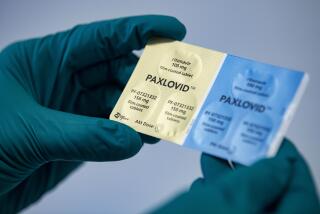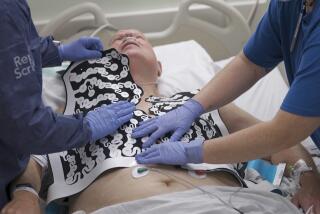Study finds use of defibrillator implants lags
- Share via
Since 1980, when a physician at the Johns Hopkins Hospital first implanted a defibrillator in a human being, doctors have found that the devices can halt sudden cardiac death in many patients whose hearts have weakened pumping ability, as well as some who have suffered a heart attack.
But a recent study by researchers at the University of Maryland Medical Center shows that about half of all patients who meet nationally accepted guidelines for treatment with implantable cardioverter-defibrillators, known as ICDs, are not receiving the recommended treatment.
Based on records from 167 cardiology practices throughout the United States, the study also found that older patients, African Americans and those without health insurance were less likely than other patients to receive the devices. Heart-failure patients treated outside the Northeast were less likely to be treated in accordance with the guidelines.
“We found that compliance with the national guidelines ranged from wonderful — 100% of the time — to complete disregard,” said Mandeep R. Mehra, chief of cardiology at the University of Maryland Medical Center and lead author of the study.
“At least half of the patients studied were eligible for the devices, but we found that of those, only half were receiving ICDs. Why? That is step No. 2. We need to understand why.”
Guidelines for using the device are agreed upon by the American College of Cardiologists, the American Heart Assn. and the Heart Rhythm Society. They say patients can benefit from ICDs if they have had a ventricular arrhythmia before, if they have suffered a heart attack that weakened and scarred the heart or if they have mild to moderate symptoms of heart failure.
In the last decade, a growing number of clinical studies have proved that implantation of defibrillators in eligible patients can reduce mortality by about 30%, said Hugh Calkins, professor of medicine and director of electrophysiology at Johns Hopkins School of Medicine.
The battery-run devices are programmed to detect arrhythmia and to restore a normal rhythm by shocking the heart. One in 14 patients with an ICD will suffer a rhythm disorder within two years that will trigger the device, Mehra said.
“We know that about 400,000 individuals [in the U.S., each year] have sudden cardiac death,” Calkins said. “Most people who have a cardiac arrest die — the survival rate is probably less than 10% — so the idea is, let’s put the ICD in place, and the ICD will give them a shock and prevent death.”
In the University of Maryland study, researchers reviewed medical records from 15,381 patients being treated at cardiology practices throughout the U.S.
According to the guidelines for use of ICDs, 7,532 of the patients were eligible for ICD implants, and 311 of them reported medical conditions that prevented them from undergoing the treatment. Of the 7,221 remaining patients, 3,659 — about 50% — received the devices. The study, which was published in December in the journal HeartRhythm, was funded by Medtronic Inc., a maker of ICD devices.
“This is an impressive study that confirms a message that we’ve heard before: that ICDs commonly are not implanted in patients who are indicated for the therapy,” Calkins said.
The study showed lower compliance in cases involving older patients, Mehra said. “This may reflect a notion of futility in patients, or it may reflect a choice: An older patient may say, ‘I don’t want this device.’ ”
Lack of insurance also played a role in lack of compliance, as well as geography. Race too was a factor. In contrast, Mehra said, cardiology practices in the Northeast complied more frequently with guidelines — as did practices that took a “team approach” to heart-failure management and whose members included specialists.
“This study points to a common problem in medicine: We train doctors who are good at treating a disease but not at preventing a disease,” said Kenneth Ellenbogen, professor of cardiology at the Virginia Commonwealth University School of Medicine and a spokesman for the American Heart Assn.
Sometimes heart-failure patients who are informed about the devices refuse treatment, Mehra said. Advanced age may play a role (eligible patients should have more than a year to live, according to the guidelines), as may poor quality of life and complications from additional medical problems. Other patients have concerns about receiving inappropriate shocks.
“About 20 to 30% of patients who receive the device will receive an appropriate shock in the first five years. The chance of receiving an inappropriate shock is about the same. There is a major effort underway to prevent the high rate of inappropriate shocks with better programming and technology,” said Calkins.
Heart-failure patients should ask their physicians what their “ejection fraction” is, said Calkins. The ejection fraction measures the percent of blood squeezed out of the heart each time the heart contracts. “If the ejection fraction is 35% or less, then the informed patient should be asking his physician if he should be getting a defibrillator.”
Overall, Mehra said, the study indicates a need for greater understanding of the guidelines among physicians, a need for expanded health insurance so that patients can afford the devices and greater use of a team approach to heart-failure treatments, “which allows groups of experts to care for patient in a ‘one-stop-shop’ model.”
health@latimes.com






